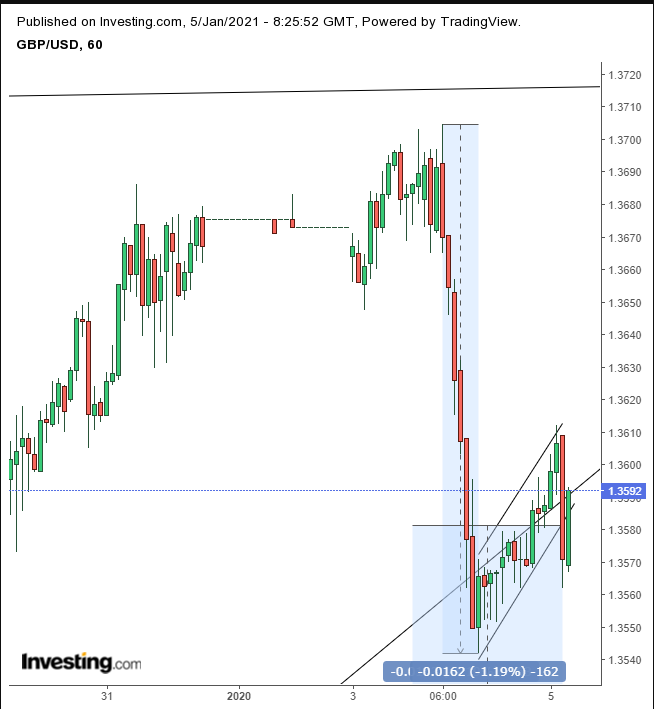As of the time of writing, the British pound is little changed from yesterday’s close, trading at about 1.3580. However, we predict the currency pair will drop within the next couple of days, falling toward 1.34.
We have a few reasons for making this call, two that are fundamental and a number that are technical.
Monday night, UK Prime Minister Boris Johnson announced}} he was initiating a third, national, COVID-19 lockdown, beginning today, Tuesday. The reason: the new coronavirus variant, which is highly contagious, has caused the rapid escalation of cases across the country. Without a stay-at-home order the country’s health system could collapse within three weeks.
Lockdowns, however, stifle the economy and sour sentiment.
As well, uncertainty surrounding the future of Britain’s financial services sector is weighing on Cable. The sector accounts for 7% of the country’s economy but wasn't covered in the Brexit deal.
The first reason is obvious to everyone, including retail traders and consumers. The second reason is less blatant, more an undercurrent preying on the minds of institutional and savvy individual investors.
The technical reason is more apparant:

On Monday, the GBP/USD pair began trading within a bearish pattern. Sterling plunged 1.63% within six straight hours, between 6:00 ET and 23:00 ET yesterday.
That drop preceded Johnson’s announcement of the lockdown. Ironically, since the Prime Minister uttered the dreaded words, the pound has been consolidating and rising. That illustrates the classic “buy-the-rumor, sell-the-news” move.
However, there's more going on. We think this seemingly innocuous price movement obscures a more 'aggressive' motive.
The price has gone up throughout a rising flag formation, following the plunge, or the “flag pole,” as short sellers were covering their positions, to return contracts to their brokers. The term “covering” actually means “buying.” So, of course, once sellers punch out—reducing supply—and buy pounds, thereby increasing demand, the price will rise.
However, if we’re right about this, the current pattern is only temporary and the pound will resume its decline. If it does, it will repeat the previous sharp drop once short sellers are done covering their tracks.
Sterling provided a downside breakdown, completing the flag at 2:00 ET, and now as we write this, the price has bounced back. However, we don’t consider that a viable rebound.
In our view it's a “return move,” to retest the pattern’s integrity, a technical term used to indicate a short squeeze. Note, the price is right on the flag bottom, which “just so happened” to meet with the broken uptrend line. That's because technical phenomena tend to coincide, which often point at the technical pressure points.
On Dec. 7 {{art-200547024||we posted a contrarian call on the pound, saying it will rise over the long-term. While that pattern did not yet complete itself, and never may, we haven’t changed our mind. This post is about the short-term.
Trading Strategies
Conservative traders should wait for the pound to fall below yesterday’s low, to extend the downtrend, then wait for another return-move, to confirm the flag’s resistance.
Moderate traders would wait for the same pattern, but for a better entry, closer to the expected resistance, not to increase their faith in the downtrend.
Aggressive traders could short right away, provided they account for their risk and their target and find that it makes sense, before they enter the trade.
Trade Sample
- Entry: 1.3590
- Stop-Loss: 1.3610
- Risk: 20 pips
- Target: 1.3490
- Reward: 100 pips
- Risk:Reward Ratio: 1:5
